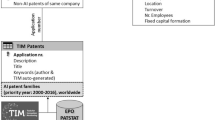Abstract
A growing consensus suggests that absorption of new technology has a bias towards skilled labour. We investigate the relationship between technology change and demand for skilled workers by taking into account an array of tests to find evidence if technology has important effects on skill premium. This paper adopts an exploratory approach. Using a panel data for Indian manufacturing industries over the period between 2001–2002 and 2013–2014, this paper depicts the rising trend of skilled workers, decomposes the trend into within and between industries, suggests capital-skill complementarity as an important factor behind increasing skill demand, and identifies whether skill-biased technology change (SBTC) is the key determinant of the trend observed. Our results show that not enough evidence can be found in favour of SBTC in case of India, a pattern comparable to 1990s as shown by previous studies. The study contributes as a good starting point to understand what accounts for the relative changes in industrial skill intensity.

Similar content being viewed by others
References
Bartel, A.P., and F.R. Lichtenberg. 1987. The Comparative Advantage of Educated Workers in Implementing New Technology. The Review of Economics and Statistics LXIX(1): 1–11.
Berman, E. 2000. Does Factor-Biased Technological Change Stifle International Convergence? Evidence from Manufacturing. NBER working paper no. 7964.
Berman, E., J. Bound, and Z. Griliches. 1994. Changes in the Demand for Skilled Labor Within US Manufacturing: Evidence from the Annual Survey of Manufacturers. The Quarterly Journal of Economics 109(2): 367–397.
Berman, E., J. Bound, and S. Machin. 1998. Implications of Skill-Biased Technological Change: International Evidence. The Quarterly Journal of Economics 113(4): 1245–1279.
Berman, E., and S. Machin. 2000a. Skill-Biased Technology Transfer Around the World. Oxford Review of Economic Policy 16(3): 12–22.
Berman, E., and Machin, S. 2000b. Skill-Biased Technology Transfer: Evidence on the Factor Bias of the Technological Change in Developing Countries. Paper presented at the “Globalisation and Labour Markets” Conference, University of Nottingham, July.
Berman, E., Somanathan, R., and Tan, H.W. 2005. Is Skill-biased Technological Change Here Yet? Evidence from Indian Manufacturing in the 1990s. World Bank policy review working paper 3761, vol. 1.
Burstein, A., J. Cravino, and J. Vogel. 2013. Importing Skill-Biased Technology. American Economic Journal: Macroeconomics 5(2): 32–71.
Economist. 2017. India’s Economy: Just the Job. September 16th–22nd 2017 Issue, pp. 52–53.
Eicher, T.S. 1996. Interaction Between Endogenous Human Capital and Technological Change. Review of Economic Studies 63: 127–144.
Goldberg, P.K., and Pavcnik, N. 2007. Distributional Effects of Globalization in Developing Countries. NBER working paper series, no. 12885.
Harrison, R. 2008. Skill-Based Technology Adoption: Firm-Level Evidence from Brazil and India. The Institute for Fiscal Studies WP08/03.
Kapoor, R. 2015. Creating Jobs in India’s Organised Manufacturing Sector. The Indian Journal of Labour Economics 58(3): 349–375.
Kapoor, R. 2016. Technology, Jobs and Inequality: Evidence from India’s Manufacturing Sector. ICRIER working paper no. 313.
Kianto, A., P. Hurmelinna-Laukkanen, and P. Ritala. 2010. Intellectual Capital in Service: And Product-Oriented Companies. Journal of Intellectual Capital 11(3): 305–325.
Kijima, Y. 2006. Why did Wage Inequality Increase? Evidence from Urban India 1983–99. Journal of Development Economics 81: 97–117.
Krugman, P. 1995. Technology, Trade and Factor Prices. NBER working paper 5355.
Krusell, P., L.E. Ohanian, J. Ríos-Rull, and G.L. Violante. 2000. Capital-Skill Complementarity and Inequality: A Macroeconomic Analysis. Econometrica 68(5): 1029–1053.
Machin, S., and J. Van Reenen. 1998. Technology and Changes in Skill Structure: Evidence from Seven OECD Countries. The Quarterly Journal of Economics 113(4): 1215–1244.
Mincer, J. 1989. Human Capital Responses to Technological Change in the Labor Market. NBER working paper no. 3207.
Nelson, R.R., and E.S. Phelps. 1966. Investment in Humans, Technological Diffusion, and Economic Growth. American Economic Review 56(2): 69–75.
Solow, R.M. 1957. Technical Change and the Aggregate Production Function. The Review of Economics and Statistics 39(3): 312–320.
Verhoogen, E.A. 2008. Trade, Quality Upgrading, and Wage Inequality: In the Mexican Manufacturing Sector. The Quarterly Journal of Economics 123(2): 489–530.
Violante, G.L. 2008. Skill-biased Technical Change. In The New Palgrave Dictionary of Economics, ed. S.N. Darlauf and L.E. Blume. New York, NY: Palgrave Macmillan.
Zhu, S.C., and D. Trefler. 2005. Trade and Inequality in Developing Countries: A General Equilibrium Analysis. Journal of International Economics 65: 21–48.
Author information
Authors and Affiliations
Corresponding author
Additional information
Publisher's Note
Springer Nature remains neutral with regard to jurisdictional claims in published maps and institutional affiliations.
We are grateful for their comments on an earlier version of this paper to the participants of: the Scottish Economic Society Annual Conference, Perth, Scotland 15–17 April 2018; 60th Annual Conference of the Indian Society of Labour Economics, Mumbai, India December 2018; 14th Annual Conference on Economic Growth and Development, Delhi, India December 2018.
Appendix
Appendix
See Fig. 2.
Rights and permissions
About this article
Cite this article
Virmani, S. Are Technology Transfers Skill Biased?. Ind. J. Labour Econ. 62, 239–263 (2019). https://doi.org/10.1007/s41027-019-00171-y
Published:
Issue Date:
DOI: https://doi.org/10.1007/s41027-019-00171-y
Keywords
- Skill-biased technology change
- Within- and between-industry decomposition
- Capital-skill complementarity
- Technology indicators
- Service-oriented industries





